sensor TOYOTA COROLLA 2022 (in English) Repair Manual
[x] Cancel search | Manufacturer: TOYOTA, Model Year: 2022, Model line: COROLLA, Model: TOYOTA COROLLA 2022Pages: 678, PDF Size: 147.24 MB
Page 288 of 678
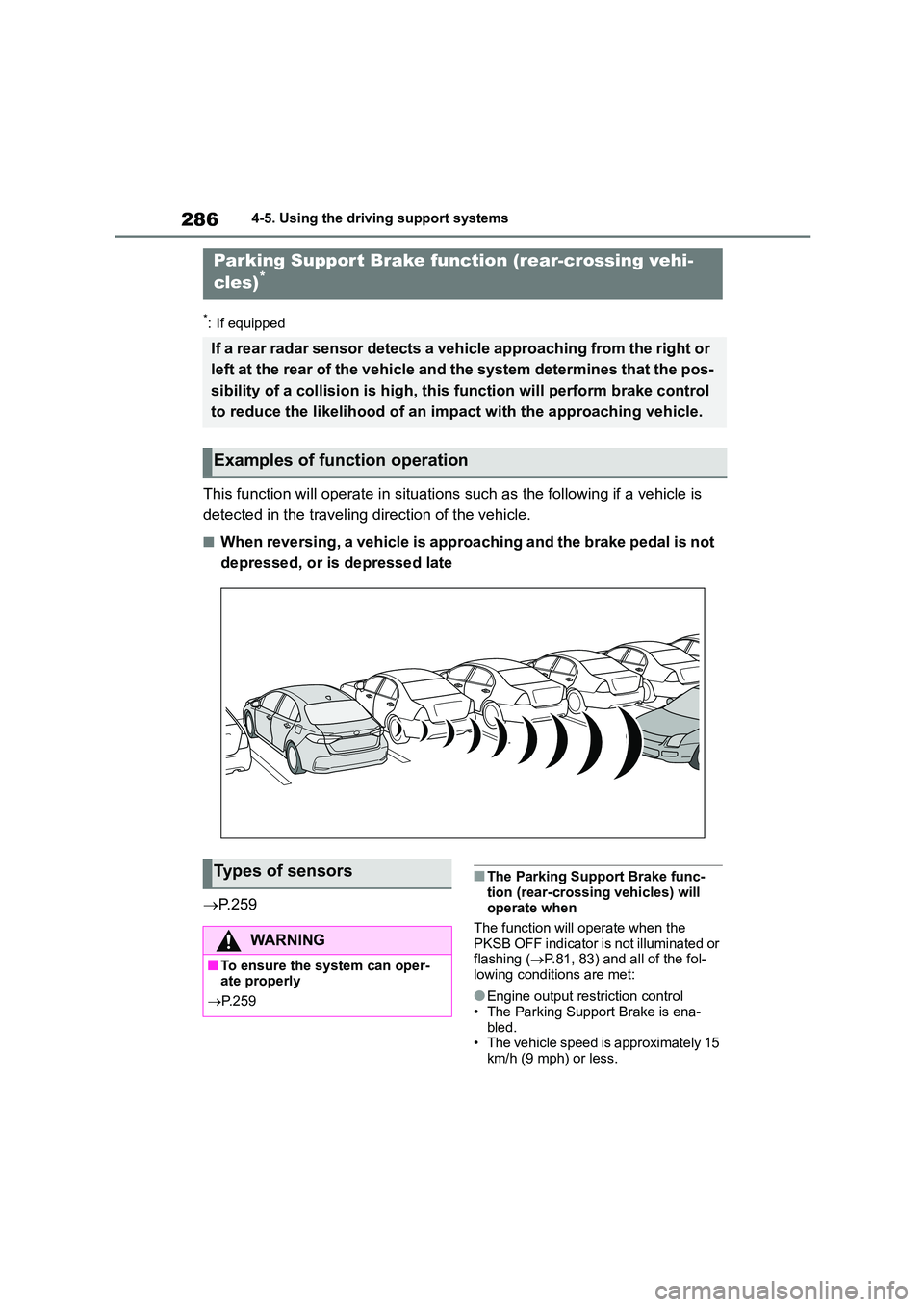
2864-5. Using the driving support systems
*: If equipped
This function will operate in situations such as the following if a vehicle is
detected in the traveling direction of the vehicle.
■When reversing, a vehicle is approaching and the brake pedal is not
depressed, or is depressed late
P. 2 5 9
■The Parking Support Brake func-
tion (rear-crossing vehicles) will operate when
The function will operate when the
PKSB OFF indicator is not illuminated or flashing ( P.81, 83) and all of the fol-
lowing conditions are met:
●Engine output restriction control • The Parking Support Brake is ena-
bled.
• The vehicle speed is approximately 15 km/h (9 mph) or less.
Parking Suppor t Brake function (rear-crossing vehi-
cles)*
If a rear radar sensor detects a vehicle approaching from the right or
left at the rear of the vehicle and the system determines that the pos-
sibility of a collision is high, this function will perform brake control
to reduce the likelihood of an impact with the approaching vehicle.
Examples of function operation
Types of sensors
WA R N I N G
■To ensure the system can oper-
ate properly
P.259
Page 293 of 678
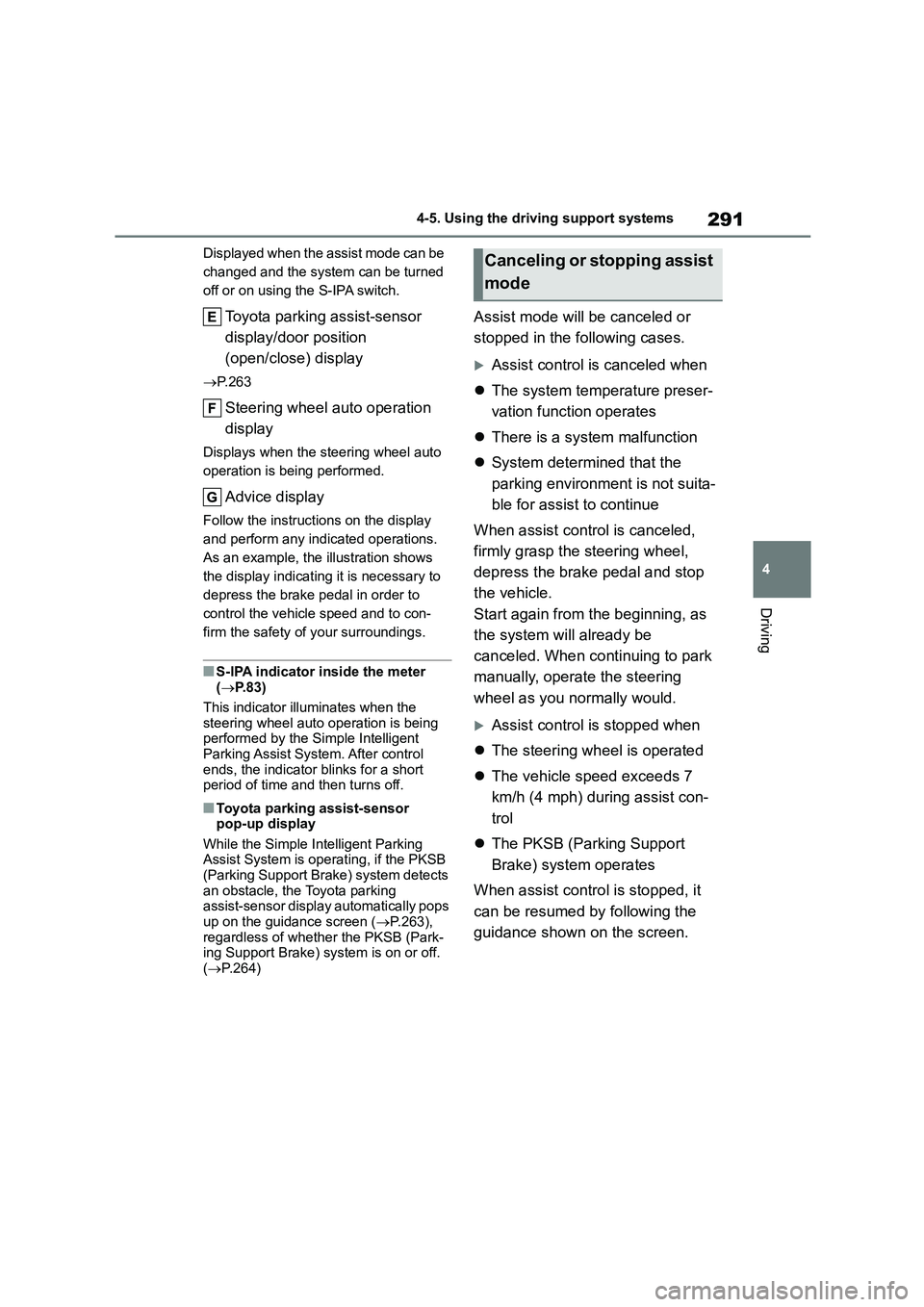
291
4
4-5. Using the driving support systems
Driving
Displayed when the assist mode can be
changed and the system can be turned
off or on using the S-IPA switch.
Toyota parking assist-sensor
display/door position
(open/close) display
P.263
Steering wheel auto operation
display
Displays when the steering wheel auto
operation is being performed.
Advice display
Follow the instructions on the display
and perform any indicated operations.
As an example, the illustration shows
the display indicating it is necessary to
depress the brake pedal in order to
control the vehicle speed and to con-
firm the safety of your surroundings.
■S-IPA indicator inside the meter ( P. 8 3 )
This indicator illuminates when the
steering wheel auto operation is being performed by the Simple Intelligent
Parking Assist Syst em. After control
ends, the indicator blinks for a short period of time and then turns off.
■Toyota parking assist-sensor
pop-up display
While the Simple Intelligent Parking
Assist System is operating, if the PKSB (Parking Support Brak e) system detects
an obstacle, the Toyota parking
assist-sensor display automatically pops up on the guidance screen ( P.263),
regardless of whether the PKSB (Park-
ing Support Brake) system is on or off. ( P.264)
Assist mode will be canceled or
stopped in the following cases.
Assist control is canceled when
The system temperature preser-
vation function operates
There is a system malfunction
System determined that the
parking environment is not suita-
ble for assist to continue
When assist control is canceled,
firmly grasp the steering wheel,
depress the brake pedal and stop
the vehicle.
Start again from the beginning, as
the system will already be
canceled. When continuing to park
manually, operate the steering
wheel as you normally would.
Assist control is stopped when
The steering wheel is operated
The vehicle speed exceeds 7
km/h (4 mph) during assist con-
trol
The PKSB (Parking Support
Brake) system operates
When assist contro l is stopped, it
can be resumed by following the
guidance shown on the screen.
Canceling or stopping assist
mode
Page 297 of 678
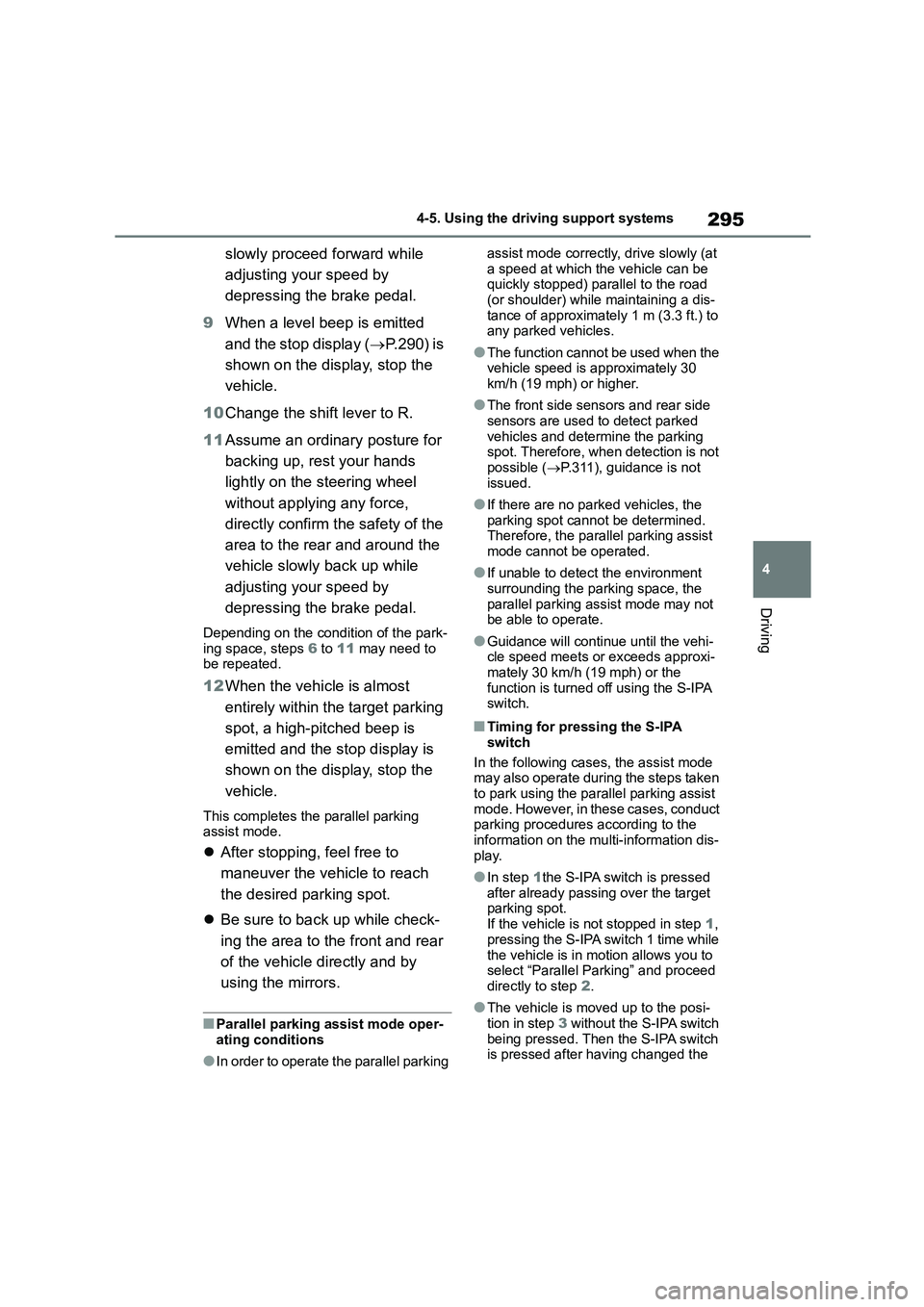
295
4
4-5. Using the driving support systems
Driving
slowly proceed forward while
adjusting your speed by
depressing the brake pedal.
9 When a level beep is emitted
and the stop display ( P.290) is
shown on the display, stop the
vehicle.
10 Change the shift lever to R.
11 Assume an ordinary posture for
backing up, rest your hands
lightly on the steering wheel
without applying any force,
directly confirm the safety of the
area to the rear and around the
vehicle slowly back up while
adjusting your speed by
depressing the brake pedal.
Depending on the condition of the park-
ing space, steps 6 to 11 may need to be repeated.
12 When the vehicle is almost
entirely within the target parking
spot, a high-pitched beep is
emitted and the stop display is
shown on the display, stop the
vehicle.
This completes th e parallel parking assist mode.
After stopping, feel free to
maneuver the vehicle to reach
the desired parking spot.
Be sure to back up while check-
ing the area to the front and rear
of the vehicle directly and by
using the mirrors.
■Parallel parking assist mode oper-
ating conditions
●In order to operate the parallel parking
assist mode correctly, drive slowly (at
a speed at which the vehicle can be quickly stopped) parallel to the road
(or shoulder) while maintaining a dis-
tance of approximately 1 m (3.3 ft.) to any parked vehicles.
●The function cannot be used when the vehicle speed is approximately 30
km/h (19 mph) or higher.
●The front side sensors and rear side
sensors are used to detect parked
vehicles and determine the parking spot. Therefore, when detection is not
possible ( P.311), guidance is not
issued.
●If there are no parked vehicles, the
parking spot cannot be determined. Therefore, the parallel parking assist
mode cannot be operated.
●If unable to detect the environment
surrounding the parking space, the
parallel parking assist mode may not be able to operate.
●Guidance will continue until the vehi-cle speed meets or exceeds approxi-
mately 30 km/h (19 mph) or the
function is turned off using the S-IPA switch.
■Timing for pressing the S-IPA
switch
In the following cases, the assist mode may also operate during the steps taken
to park using the parallel parking assist
mode. However, in th ese cases, conduct parking procedures according to the
information on the mu lti-information dis-
play.
●In step 1the S-IPA switch is pressed
after already passing over the target parking spot.
If the vehicle is not stopped in step 1,
pressing the S-IPA switch 1 time while
the vehicle is in motion allows you to select “Parallel Parking” and proceed
directly to step 2.
●The vehicle is moved up to the posi-
tion in step 3 without the S-IPA switch
being pressed. Then the S-IPA switch is pressed after having changed the
Page 302 of 678
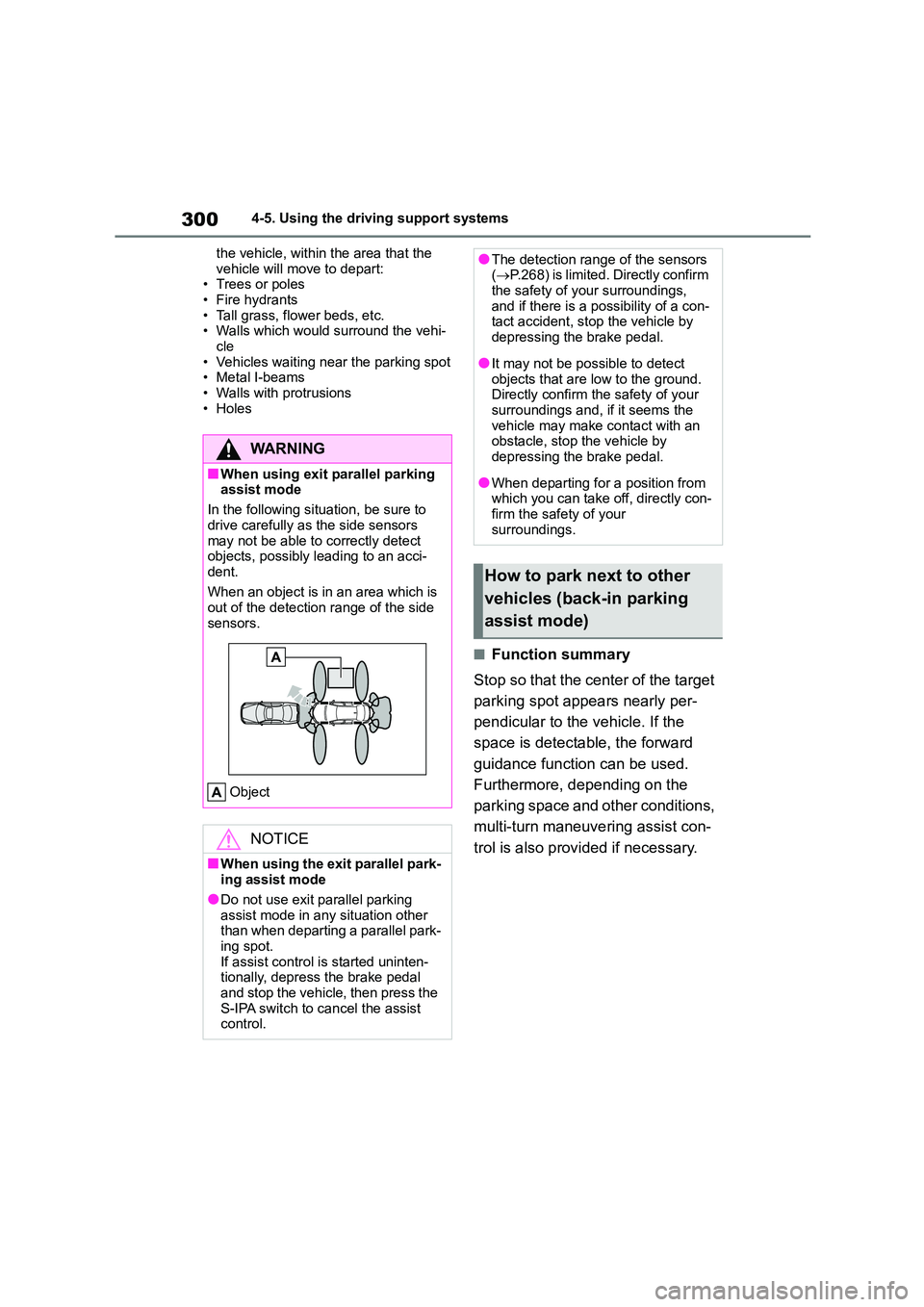
3004-5. Using the driving support systems
the vehicle, within the area that the
vehicle will move to depart: • Trees or poles
• Fire hydrants
• Tall grass, flower beds, etc. • Walls which would surround the vehi-
cle
• Vehicles waiting near the parking spot • Metal I-beams
• Walls with protrusions
•Holes
■Function summary
Stop so that the cent er of the target
parking spot appears nearly per-
pendicular to the vehicle. If the
space is detectable, the forward
guidance function can be used.
Furthermore, depending on the
parking space and other conditions,
multi-turn maneuvering assist con-
trol is also provided if necessary.
WA R N I N G
■When using exit parallel parking assist mode
In the following situation, be sure to
drive carefully as the side sensors may not be able to correctly detect
objects, possibly leading to an acci-
dent.
When an object is in an area which is
out of the detection range of the side
sensors.
Object
NOTICE
■When using the exit parallel park- ing assist mode
●Do not use exit parallel parking
assist mode in any situation other than when departing a parallel park-
ing spot.
If assist control is started uninten- tionally, depress the brake pedal
and stop the vehicle, then press the
S-IPA switch to cancel the assist control.
●The detection range of the sensors ( P.268) is limited. Directly confirm
the safety of your surroundings,
and if there is a possibility of a con- tact accident, stop the vehicle by
depressing the brake pedal.
●It may not be possible to detect
objects that are low to the ground.
Directly confirm the safety of your surroundings and, if it seems the
vehicle may make contact with an
obstacle, stop the vehicle by depressing the brake pedal.
●When departing for a position from which you can take off, directly con-
firm the safety of your
surroundings.
How to park next to other
vehicles (back-in parking
assist mode)
Page 306 of 678
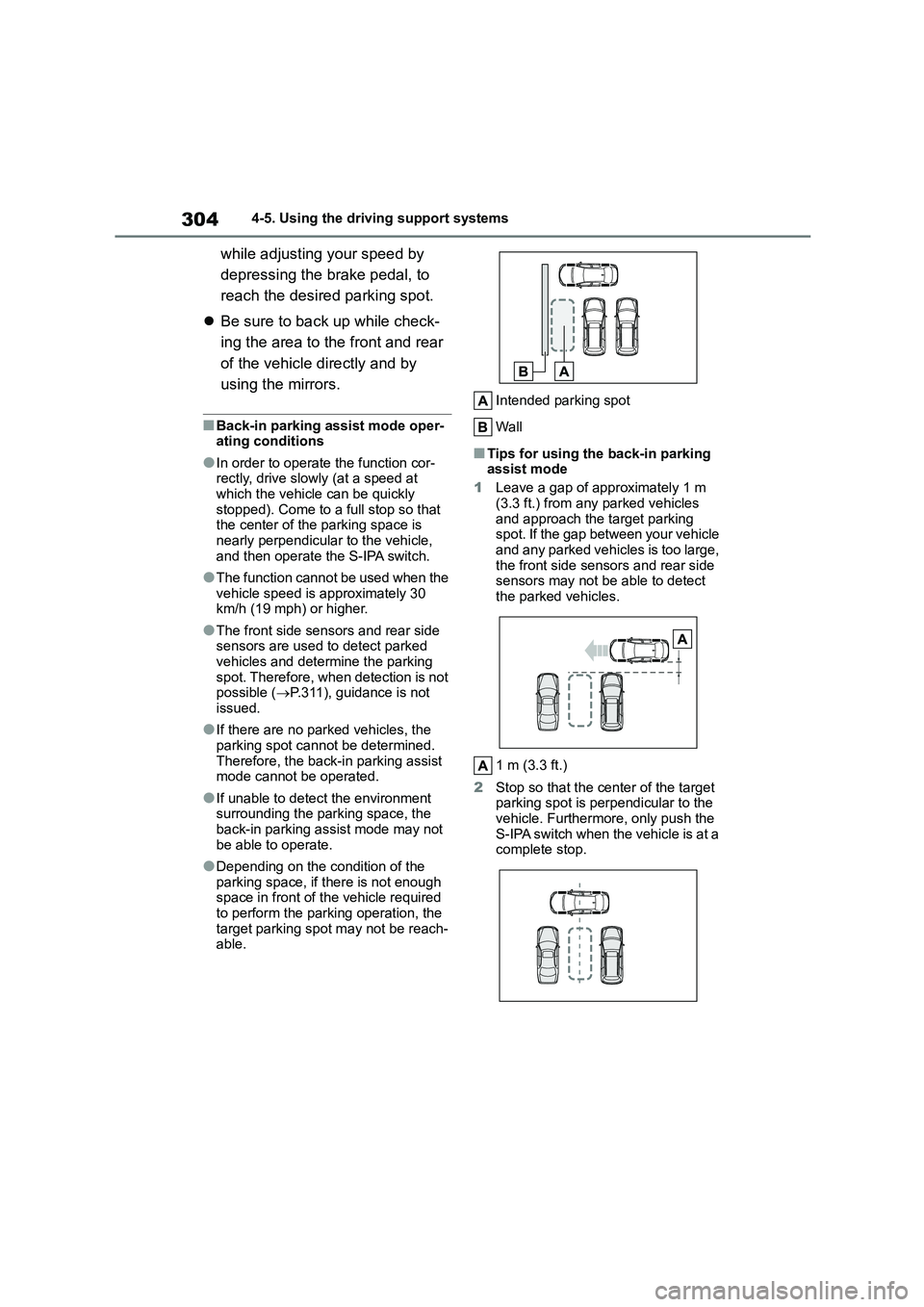
3044-5. Using the driving support systems
while adjusting your speed by
depressing the brake pedal, to
reach the desired parking spot.
Be sure to back up while check-
ing the area to the front and rear
of the vehicle directly and by
using the mirrors.
■Back-in parking assist mode oper-
ating conditions
●In order to operate the function cor-
rectly, drive slowly (at a speed at which the vehicle can be quickly
stopped). Come to a full stop so that
the center of the parking space is nearly perpendicular to the vehicle,
and then operate the S-IPA switch.
●The function cannot be used when the
vehicle speed is approximately 30
km/h (19 mph) or higher.
●The front side sensors and rear side
sensors are used to detect parked vehicles and determine the parking
spot. Therefore, when detection is not
possible ( P.311), guidance is not issued.
●If there are no parked vehicles, the parking spot cannot be determined.
Therefore, the back-in parking assist
mode cannot be operated.
●If unable to detect the environment
surrounding the parking space, the
back-in parking assist mode may not be able to operate.
●Depending on the condition of the parking space, if there is not enough
space in front of the vehicle required
to perform the parking operation, the target parking spot may not be reach-
able.
Intended parking spot
Wall
■Tips for using the back-in parking assist mode
1 Leave a gap of approximately 1 m
(3.3 ft.) from any parked vehicles
and approach the target parking spot. If the gap between your vehicle
and any parked vehicles is too large,
the front side sensors and rear side sensors may not be able to detect
the parked vehicles.
1 m (3.3 ft.)
2 Stop so that the center of the target parking spot is perpendicular to the
vehicle. Furthermore, only push the
S-IPA switch when the vehicle is at a complete stop.
Page 308 of 678
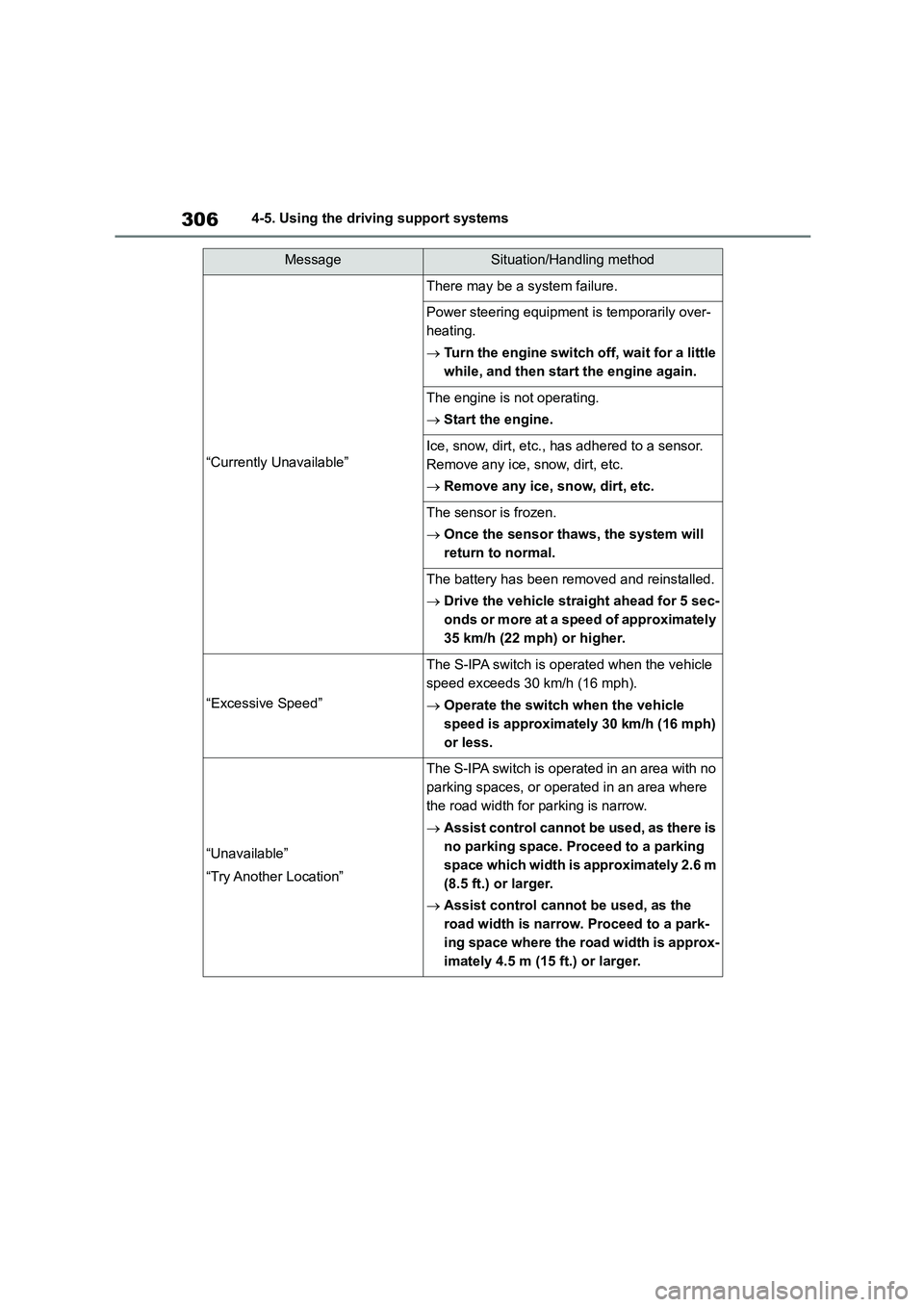
3064-5. Using the driving support systems
“Currently Unavailable”
There may be a system failure.
Power steering equipment is temporarily over-
heating.
Turn the engine switch off, wait for a little
while, and then start the engine again.
The engine is not operating.
Start the engine.
Ice, snow, dirt, etc., has adhered to a sensor.
Remove any ice, snow, dirt, etc.
Remove any ice, snow, dirt, etc.
The sensor is frozen.
Once the sensor thaws, the system will
return to normal.
The battery has been removed and reinstalled.
Drive the vehicle straight ahead for 5 sec-
onds or more at a speed of approximately
35 km/h (22 mph) or higher.
“Excessive Speed”
The S-IPA switch is operated when the vehicle
speed exceeds 30 km/h (16 mph).
Operate the switch when the vehicle
speed is approximately 30 km/h (16 mph)
or less.
“Unavailable”
“Try Another Location”
The S-IPA switch is operated in an area with no
parking spaces, or operated in an area where
the road width for parking is narrow.
Assist control cannot be used, as there is
no parking space. Proceed to a parking
space which width is approximately 2.6 m
(8.5 ft.) or larger.
Assist control cannot be used, as the
road width is narrow. Proceed to a park-
ing space where the road width is approx-
imately 4.5 m (15 ft.) or larger.
MessageSituation/Handling method
Page 312 of 678
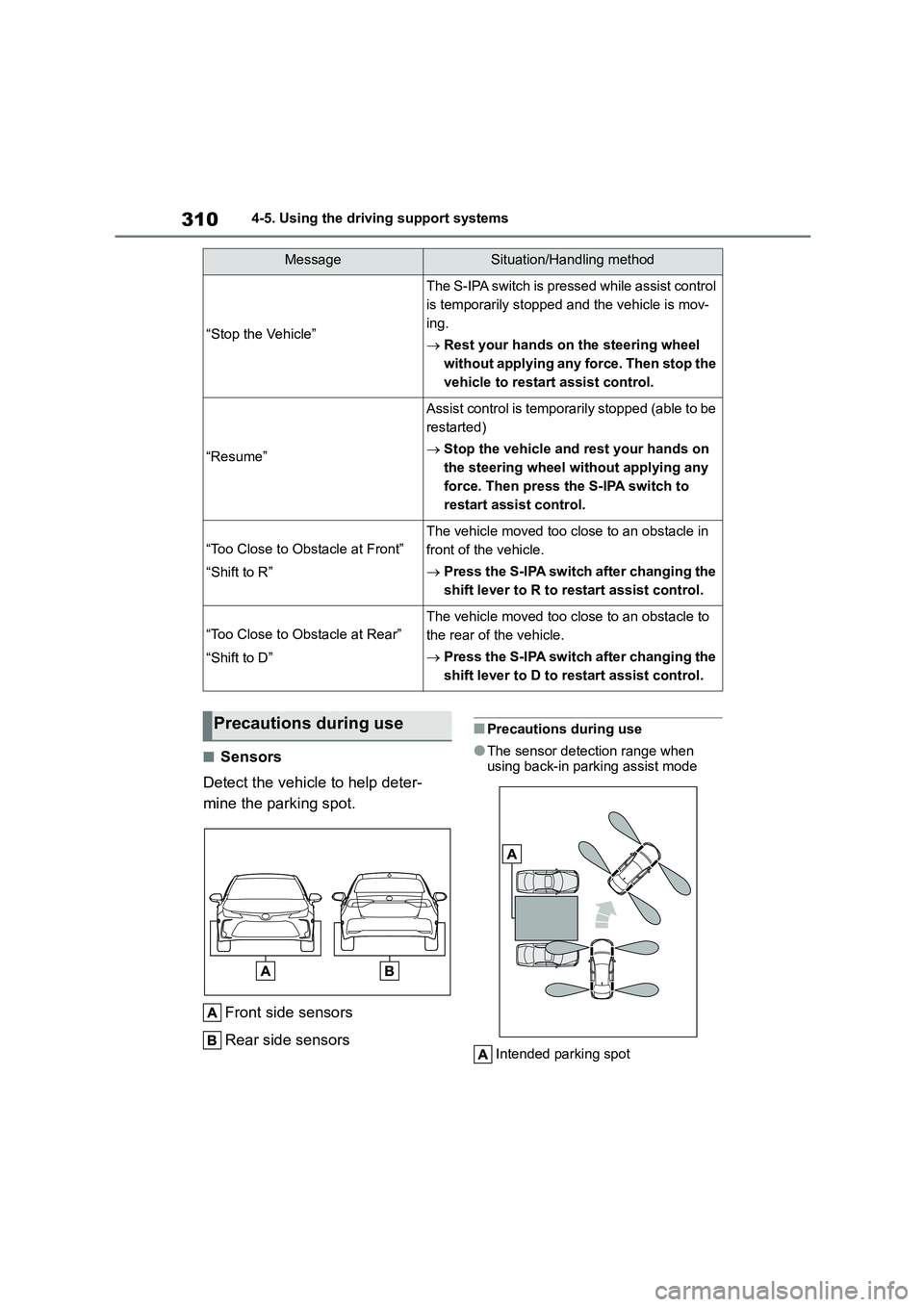
3104-5. Using the driving support systems
■Sensors
Detect the vehicle to help deter-
mine the parking spot.
Front side sensors
Rear side sensors
■Precautions during use
●The sensor detection range when
using back-in parking assist mode
Intended parking spot
“Stop the Vehicle”
The S-IPA switch is pressed while assist control
is temporarily stopped and the vehicle is mov-
ing.
Rest your hands on the steering wheel
without applying any force. Then stop the
vehicle to restart assist control.
“Resume”
Assist control is temporarily stopped (able to be
restarted)
Stop the vehicle and rest your hands on
the steering wheel without applying any
force. Then press the S-IPA switch to
restart assist control.
“Too Close to Obstacle at Front”
“Shift to R”
The vehicle moved too close to an obstacle in
front of the vehicle.
Press the S-IPA switch after changing the
shift lever to R to restart assist control.
“Too Close to Obstacle at Rear”
“Shift to D”
The vehicle moved too close to an obstacle to
the rear of the vehicle.
Press the S-IPA switch after changing the
shift lever to D to restart assist control.
MessageSituation/Handling method
Precautions during use
Page 313 of 678
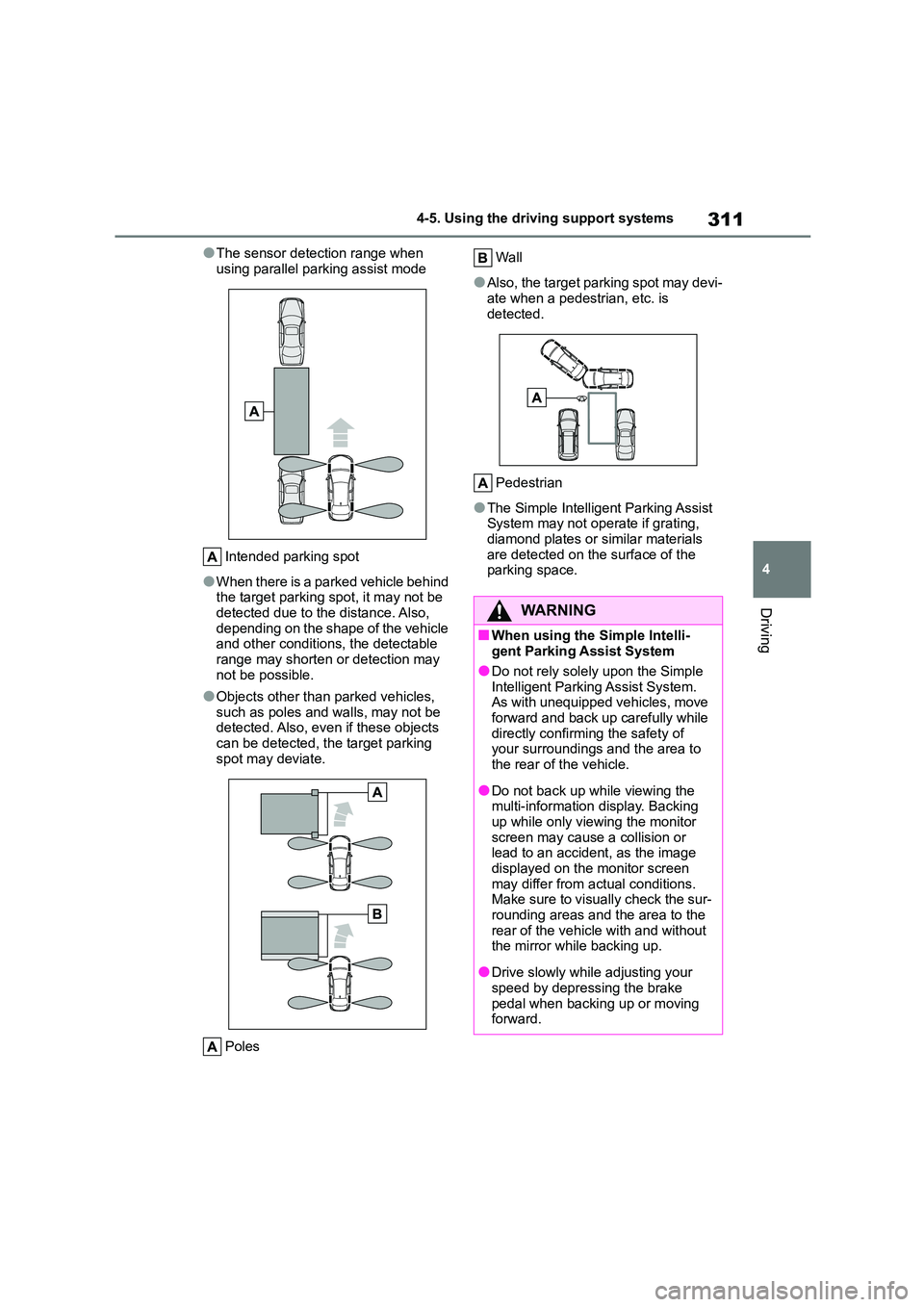
311
4
4-5. Using the driving support systems
Driving
●The sensor detection range when
using parallel parking assist mode
Intended parking spot
●When there is a parked vehicle behind
the target parking spot, it may not be
detected due to the distance. Also, depending on the shape of the vehicle
and other conditions, the detectable
range may shorten or detection may not be possible.
●Objects other than parked vehicles, such as poles and walls, may not be
detected. Also, even if these objects
can be detected, the target parking spot may deviate.
Poles
Wall
●Also, the target parking spot may devi- ate when a pedestrian, etc. is
detected.
Pedestrian
●The Simple Intelligent Parking Assist
System may not operate if grating, diamond plates or similar materials
are detected on the surface of the
parking space.
WA R N I N G
■When using the Simple Intelli- gent Parking Assist System
●Do not rely solely upon the Simple
Intelligent Parking Assist System. As with unequipped vehicles, move
forward and back up carefully while
directly confirming the safety of your surroundings and the area to
the rear of the vehicle.
●Do not back up while viewing the
multi-information display. Backing
up while only viewing the monitor screen may cause a collision or
lead to an accident, as the image
displayed on the monitor screen may differ from actual conditions.
Make sure to visually check the sur-
rounding areas and the area to the rear of the vehicle with and without
the mirror while backing up.
●Drive slowly while adjusting your
speed by depressing the brake
pedal when backing up or moving forward.
Page 315 of 678
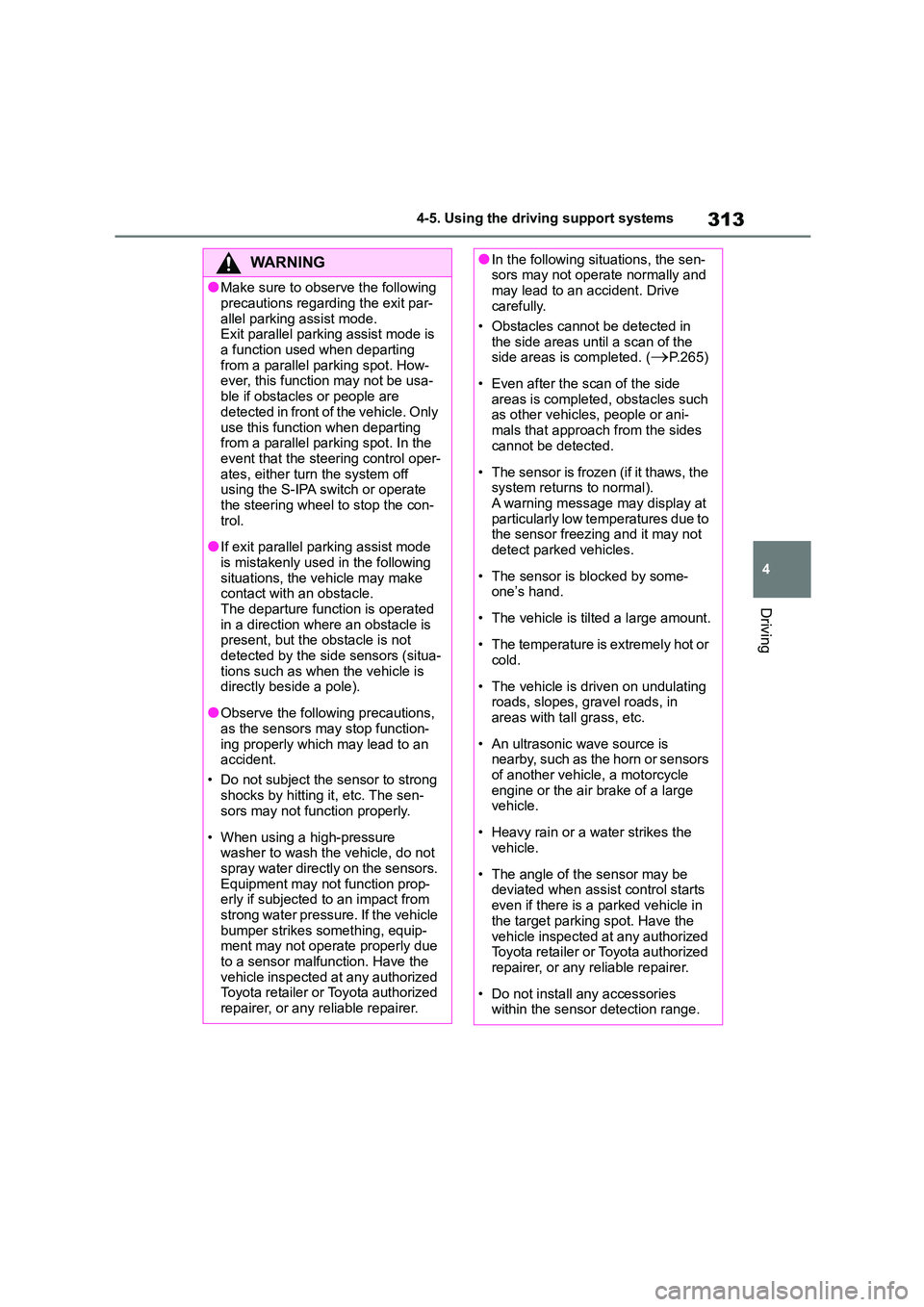
313
4
4-5. Using the driving support systems
Driving
WA R N I N G
●Make sure to observe the following
precautions regarding the exit par-
allel parking assist mode. Exit parallel parking assist mode is
a function used when departing
from a parallel parking spot. How- ever, this function may not be usa-
ble if obstacles or people are
detected in front of the vehicle. Only
use this function when departing from a parallel parking spot. In the
event that the steering control oper-
ates, either turn the system off using the S-IPA switch or operate
the steering wheel to stop the con-
trol.
●If exit parallel parking assist mode
is mistakenly used in the following situations, the vehicle may make
contact with an obstacle.
The departure function is operated in a direction where an obstacle is
present, but the obstacle is not
detected by the side sensors (situa- tions such as when the vehicle is
directly beside a pole).
●Observe the following precautions,
as the sensors may stop function-
ing properly which may lead to an accident.
• Do not subject the sensor to strong
shocks by hitting it, etc. The sen- sors may not function properly.
• When using a high-pressure washer to wash the vehicle, do not
spray water directly on the sensors.
Equipment may not function prop- erly if subjected to an impact from
strong water pressure. If the vehicle
bumper strikes something, equip- ment may not operate properly due
to a sensor malfunction. Have the
vehicle inspected at any authorized Toyota retailer or Toyota authorized
repairer, or any reliable repairer.
●In the following situations, the sen- sors may not operate normally and
may lead to an accident. Drive
carefully.
• Obstacles cannot be detected in
the side areas until a scan of the
side areas is completed. (P.265)
• Even after the scan of the side
areas is completed, obstacles such as other vehicles, people or ani-
mals that approach from the sides
cannot be detected.
• The sensor is frozen (if it thaws, the
system returns to normal). A warning message may display at
particularly low temperatures due to
the sensor freezing and it may not detect parked vehicles.
• The sensor is blocked by some- one’s hand.
• The vehicle is tilted a large amount.
• The temperature is extremely hot or
cold.
• The vehicle is driven on undulating
roads, slopes, gravel roads, in areas with tall grass, etc.
• An ultrasonic wave source is nearby, such as the horn or sensors
of another vehicle, a motorcycle
engine or the air brake of a large vehicle.
• Heavy rain or a water strikes the vehicle.
• The angle of the sensor may be deviated when assist control starts
even if there is a parked vehicle in
the target parking spot. Have the
vehicle inspected at any authorized Toyota retailer or Toyota authorized
repairer, or any reliable repairer.
• Do not install any accessories
within the sensor detection range.
Page 318 of 678
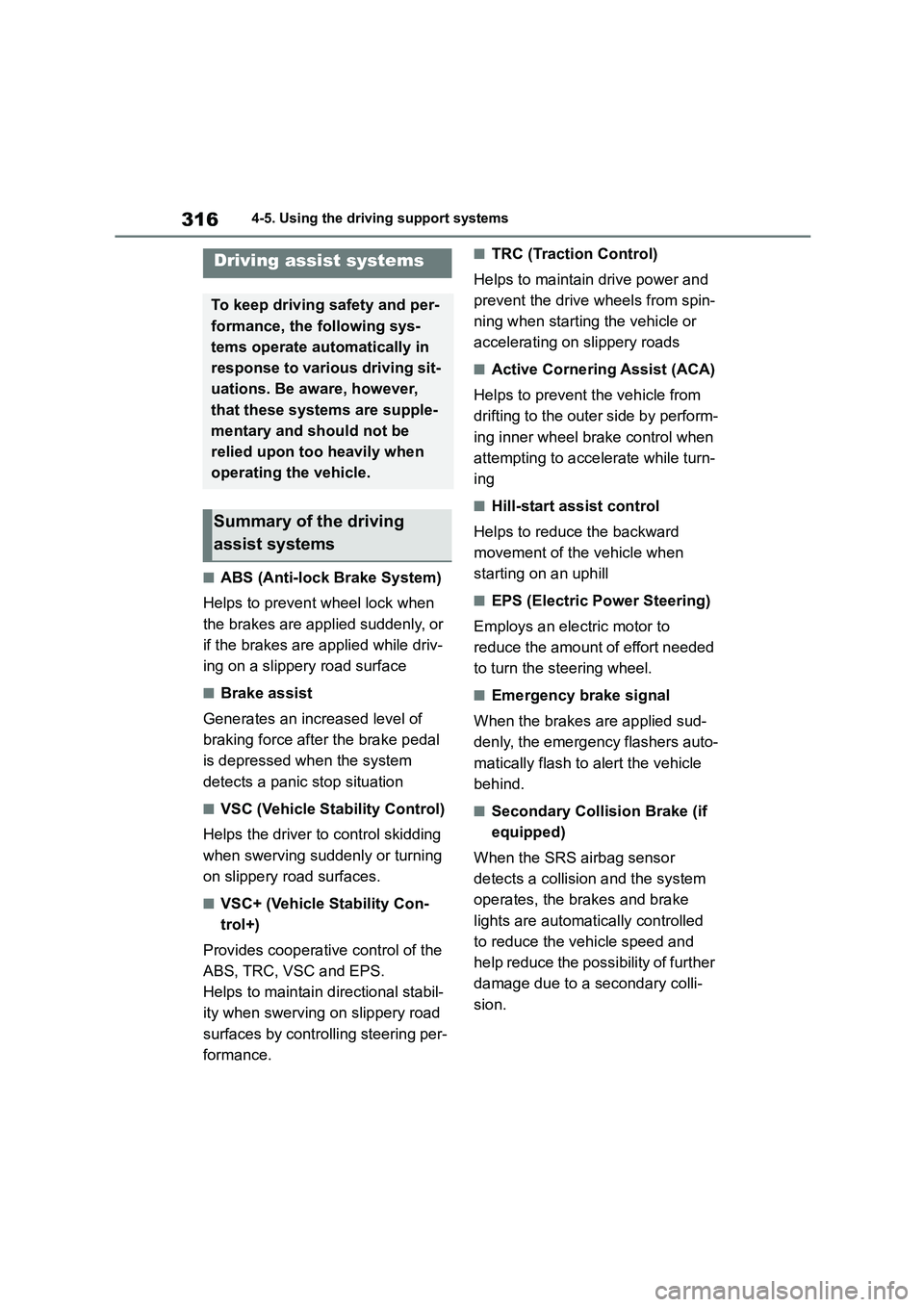
3164-5. Using the driving support systems
■ABS (Anti-lock Brake System)
Helps to prevent wheel lock when
the brakes are applied suddenly, or
if the brakes are applied while driv-
ing on a slippery road surface
■Brake assist
Generates an increased level of
braking force after the brake pedal
is depressed when the system
detects a panic stop situation
■VSC (Vehicle St ability Control)
Helps the driver to control skidding
when swerving suddenly or turning
on slippery road surfaces.
■VSC+ (Vehicle Stability Con-
trol+)
Provides cooperative control of the
ABS, TRC, VSC and EPS.
Helps to maintain directional stabil-
ity when swerving on slippery road
surfaces by controlling steering per-
formance.
■TRC (Traction Control)
Helps to maintain drive power and
prevent the drive wheels from spin-
ning when starting the vehicle or
accelerating on slippery roads
■Active Cornering Assist (ACA)
Helps to prevent the vehicle from
drifting to the outer side by perform-
ing inner wheel brake control when
attempting to acce lerate while turn-
ing
■Hill-start assist control
Helps to reduce the backward
movement of the vehicle when
starting on an uphill
■EPS (Electric Po wer Steering)
Employs an electric motor to
reduce the amount of effort needed
to turn the steering wheel.
■Emergency brake signal
When the brakes are applied sud-
denly, the emergency flashers auto-
matically flash to alert the vehicle
behind.
■Secondary Collision Brake (if
equipped)
When the SRS airbag sensor
detects a collisi on and the system
operates, the brakes and brake
lights are automatically controlled
to reduce the vehicle speed and
help reduce the poss ibility of further
damage due to a secondary colli-
sion.
Driving assist systems
To keep driving safety and per-
formance, the following sys-
tems operate au tomatically in
response to various driving sit-
uations. Be aware, however,
that these systems are supple-
mentary and should not be
relied upon too heavily when
operating the vehicle.
Summary of the driving
assist systems